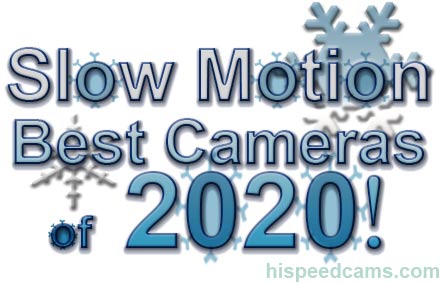As the end of 2020 nears, it’s time to take a look back through the year’s camera releases amid the COVID 19 chaos, and see which delivered on the price/performance bracket with slow motion frame rates as the primary goal. Phone slow motion took a back seat this year as the interest of the feature in phones was subdued or even eliminated. Our Best Slow Motion Cameras Of 2020 have been selected and ordered by recommendation!
We saw some surprises including a mostly affordable 4k slow motion solution and the adoption of 4k 120fps on many cameras which makes us think 240fps at UHD should be something to think about in the coming years as a regular option once 8k video is commonplace on consumer recording devices and TVs. The increase in resolution should theoretically allow for a lot of 4k frame rates to be offered as 8k delivers 4x the pixel count of 4k for any given frame rate. Keep on reading for our 2020 picks!
BEST SLOW MOTION CAMERAS of 2020:
Without further ado here are what we believe are the best value slow motion cameras in their respective categories for the year 2020:
Best Slow Motion Phone Category:
3rd Place) Sony Xperia 5 II:
The Sony Xperia 5 II is all about capturing the best video possible on a smartphone and in HDR. The kick here is that the phone is capable of 4k 120fps in full HDR which is pretty much class-leading.
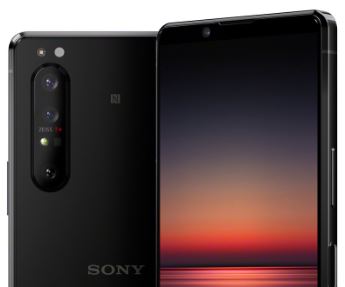
The footage below will give you a taste of what the phone can do. In good light, it will let you capture excellent quality 4k 120p footage with the possibility to grade as it records a gradable flat profile. In low light, it will be a pretty unremarkable image with grain and artifacts as could be expected from the light requirements when shooting at high speed.
Sony Xperia 5 II: 4K 120fps video footage by CNET Highlights:
Sony Xperia 5 II Slow Motion Specs:
- 120fps 4k
- 60fps 1080p
This is one of the first phones to offer 120fps in 4k which will probably become a standard spec in 2021 for flagships. However absent is the slow motion at 1080p which considering the 4k oomph, it should have been capable of 480fps at 1080p or similar. It is a shame that the spec was completely avoided considering HDR in 120fps 4k requires 240fps full pixel readout before merging. In theory, 240fps non-HDR is possible on this phone but not available for unspecified reasons. Phones are becoming more powerful by the day and this is one that has our attention. The just under $1k price tag is not ideal but some of the best phones are going to cost you.
2nd Place) OnePlus 8T:
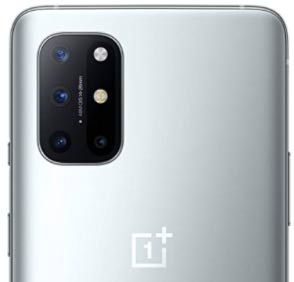
One Plus continues to offer compelling slow motion features on their phones with 480fps 1080p and up to 480fps at 720p. It gives you a quad 48MP camera module which is literally insane considering the phone sells for under $750USD and has 120hz refresh rate. Feature-wise it has probably everything under the sun and then some and will not disappoint in the performance realm.
Fireworks in Slow motion – OnePlus 8T 480fps in dark by sternking:
OnePlus 8T Slow Motion Specs:
4K video at 30/60 fps
1080p video at 30/60 fps
Super Slow Motion: 1080p video at 240 fps, 720p video at 480 fps
Time-Lapse: 1080p at 30 fps, 4K at 30 fps
While the OnePlus 8T phone will not win a contest for video quality, the 480fps mode is actually useful and the 240fps 1080p mode while less detailed than others, shows good color and low noise. All in all a good slow motion option if you do not mind the drop in video quality. You get the frames but not the resolution. But for the price compared to other phones, it seems like one of the best bargains out there for under $650 in some places.
1st Place) Huawei Mate 40 Pro & P40 Pro:
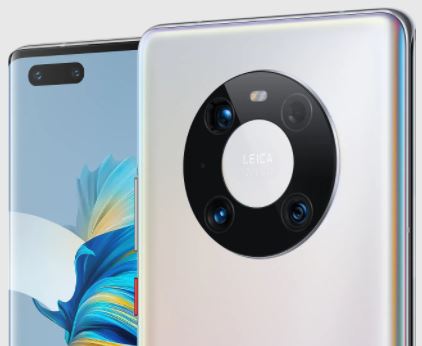
Huawei continues to bring slow motion features to their phones that eclipse all other manufacturers. The Mate 40 Pro and P40 Pro phones released this year can shoot in super high frame rates with a usable resolution for non-broadcast applications. They can shoot real 1920fps at 720p and up to 480fps at 1080p. Then they can interpolate up to a crazy slow 7680fps on the P40 Pro and 3840fps on the Mate 40 Pro. The interpolation is very good and built with machine learning algorithms. It will not win a prize in labs but it will deliver very good motion prediction for many real-world shots.
Huawei Mate 40 Pro Super Slow Motion Video! by FoneTech:
https://www.youtube.com/watch?v=yY4fuaqXMgs
P40 Pro : 4K@30/60fps, 1080p@30/60fps, 720@7680fps, 1080p@960fps
Mate 40 Pro: 4K@30/60fps, 1080p@30/60/120/240/480fps, 720p@960fps, 720p@3840fps
Huawei P40 Pro Slow Motion – 7680 FPS Ultra Slow Motion by MKP Captain:
We have to point out that Huawei phones are restricted in the USA by not allowing carrier sales and or google apps and app store to be installed from the factory. Some hacks exist that allow you to make the phones work more normally but it is a step many people just don’t want to mess with. It is clear Huawei is ahead of every other manufacturer including Samsung and Apple when it comes to camera hardware and features. We may see some of this tech start to reach other brands as competition increases.
Congratulations to Huawei for improving slow motion recording on their phones over every other brand out there. We hope to see much-improved resolution from them in the future!
Note on iPhone 12: Apple’s iPhone 12 Pro and 12 have the same 240fps 1080p maximum slow motion recording feature as the iPhone 11. It offers the same great quality with some improvements in dynamic range, color, and codec bit rate compared to the iPhone 11 variants. These are great 120fpa nd 240fps phones but by not going higher in fps, we had to leave them out for this year. Maybe Apple will surprise us in 2021 with 4k 120p HDR and or 1080p 480fps. But it will be a tall order.
![]()
Mid Range Professional Cameras:
This year we have quite a few new cameras that have great quality slow motion we have chosen 3 finalists that really allow you to shoot quality production-ready high frame rate footage.
3rd Place: URSA Mini Pro 12k:
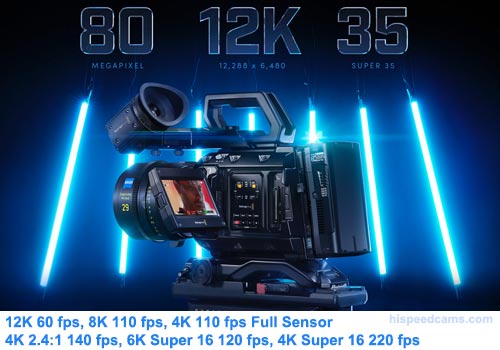
The URSA Mini Pro 12k builds on the pedigree of the URSA line of cameras to shoot an astounding 8k,12k image up to 120fps and a 4k image in Super 16 crop mode of up to 240fps. IN their BRAW with is their RAW like format with very little quality loss and minimum flexibility trade-offs with a dramatically lower bit rate.
URSA Mini Pro 12k High Speed Frame Rates:
12K 17:9 full sensor up to 60 fps
12K 2.4:1 up to 75 fps
8K DCI full sensor up to 120 fps
4K DCI full sensor up to 120 fps
8K 2.4:1 and 4K 2.4:1 up to 160 fps
6K Super 16 up to 120 fps
4K Super 16 up to 240 fps
Ursa Mini Pro 12k Slow Motion by JSFILMZ:
As you can see from the footage above, 8k and 4k slow motion is crisp and impeccable even in 12:1 compression. It is really a production-ready format with fantastic dynamic range and reduced artifacting.
Pricing & Availability:
The URSA Mini Pro 12k is available at authorized resellers for $9,995 USD. It is not cheap but considering the amount of features and quality shown here, you really can’t go wrong with this powerful and future-proof camera. Just make sure you factor in lenses and SSD storage in your budget.
2nd Place: Kinefinity MAVO Edge 8k
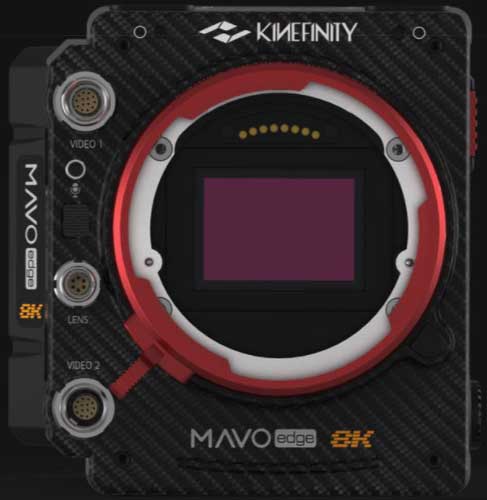
Kinefinity is a Chinese company with big performance in mind. It builds state of the art cinema cameras with quality and power rivaling the biggest out there. The pricing is also incredibly cheap compared to other cinema cameras and they are building a loyal following as more filmmakers and video producers take the leap and get one of their cameras.
The new Kinefinity MAVO Edge which shoots in 8k, is a product that in not afraid of pushing the envelope.
RESOLUTION, FRAME RATE and OPTICAL FORMAT
| Full Frame | FF 8K Wide | 8192×3456, 0.2~75fps | ProRes RAW or ProRes | 36×15.2mm, ø 39.1mm |
| FF 8K DCI | 8192×4320, 0.2~60fps | ProRes RAW or ProRes | 36x19mm, ø 40.7mm | |
| FF 8K Open Gate | 8192×5456, 0.2~48fps | ProRes RAW or ProRes | 36x24mm, ø 43.3mm | |
| FF 6K DCI (Oversample) | 6144×3240 0.2~60fps | ProRes | 36x19mm, ø 40.7mm | |
| FF 4K DCI (Oversample) | 4096×2160, 0.2~60fps | ProRes | 36x19mm, ø 40.7mm | |
| S35 | S35 6K Wide | 6144×2560, 0.2~100fps | ProRes RAW or ProRes | 27×11.3mm, ø 29.3mm |
| S35 6K DCI | 6144×3240, 0.2~80fps | ProRes RAW or ProRes | 27×14.2mm, ø 30.5mm | |
| S35 4K DCI (Oversampling) | 4096×2160, 0.2~80fps | ProRes | 27×14.2mm, ø 30.5mm | |
| S35 5K Wide | 5120×2160, 0.2~120fps | ProRes RAW or ProRes | 22.5×9.5mm, ø 24.4mm | |
| S35 5K DCI | 5120×2704, 0.2~96fps | ProRes RAW or ProRes | 22.5×11.9mm, ø 25.5mm | |
| S35 4:3 Ana | 5120×3840, 0.2~60fps | ProRes RAW or ProRes | 22.5×16.9mm, ø 28.1mm | |
| S35 6:5 Ana | 5120×4096, 0.2~60fps | ProRes RAW or ProRes | 22.5x18mm, ø 28.8mm | |
| S35 1:1 Ana | 4096×4096, 0.2~60fps | ProRes RAW or ProRes | 18x18mm, ø 25.5mm | |
| Other Cropping | 4K Wide | 4096×1600, 0.2~160fps | ProRes RAW or ProRes | |
| 4K DCI | 4096×2160, 0.2~120fps | ProRes RAW or ProRes | ||
| 2K Wide | 2048×860, 0.2~300fps | ProRes RAW or ProRes | ||
| 2K DCI | 2048×1080, 0.2~240fps | ProRes RAW or ProRes |
There is no question that the Kinefinity MAVO Edge 8k is a serious tool for the most demanding users. The quality and finish of this camera is ages apart from their first cameras and it shows a steady progression of the brand to go head-on against BlackMagic Design, RED, and ARRI with a pricing model that breaks the competition. We have heard great things from their cameras and production houses are relying more and more on the brand for capturing no compromise RAW footage that can be used in multi-million dollar productions. As crash cameras, you can now afford to use one of these in a variety of situations that you would be afraid to use a substantially more expensive camera in.
At up to 300fps in 2k and 120fps in 5k with 4k maxing out at 160fps, the camera is quite capable of shooting high frame rates with the quality you need for post-production. Just make sure you use plenty of light. The MSRP stands at $11,999 USD for the body kit. More information at the official site here!
1st Place: Sony FX6 Full-Frame Cinema Camera
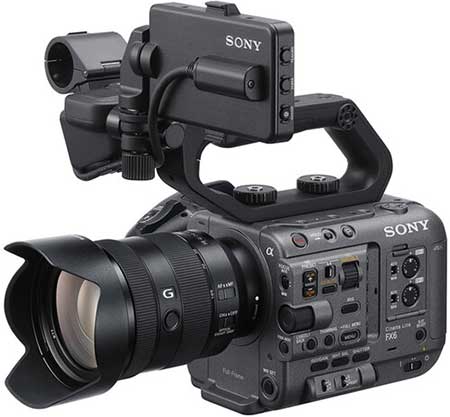
The Sony FX6 Full-Frame Cinema Camera is taking the a7s III compact camera sensor and adding a professional body interface with ergonomics, grip, better cooling, a variable ND filter and a plethora of video capture options along with the industry-leading low light with a base ISO 800 & High sensitivity ISO 12,800 to Max ISO 409,600 which can literally see in the dark.
As far as high frame rates are concerned, the camera is no slouch as it can shoot 120fps UHD 4k and up to 240fps in 1080p. All In XAVC Long GOP and XAVC-I All Intra 4:2:2 10-bit color.
| Variable Frame Rates | DCI 4K: 1 to 60 fps UHD: 1 Up to 120 fps 1080p: 1 Up to 240 fps |
While the cameras on this category above can shoot higher resolution and frame rates, the low light performance this camera offers along with the much lower price tag at just $5,998 USD for the body. It is a dependable camera that is production-ready and battle-tested by Sony to perform on most every lighting challenge.
240 fps on Waterloo Bridge – filmed with the Sony FX6 by Philip Bloom:
As you can see from the footage both 4k UHD at 120fps and 1080p at 240 fps is professional looking and very usable in production.
Full frame camera with 4:2:2 internal recording, 15 stops of dynamic range, unbeatable low light, and the ergonomic features that are class-leading makes the Sony FX6 our Midrange professional camera of 2020.
You really can’t go wrong with this kit as it is compatible with a plethora of adapters and lenses. It also offers some of the best Autofocus around.
Test SONY FX6 120fps 4k UHD by Actionmovieitaly:
The Sony FX6 is available in two kits. The Body only for $5998 USD and a Camera/Lens kit with a 24mm to 105mm Lens with full AF tracking capabilities for $7198 USD.
![]()
Action Camera: GoPro Hero 9 Black!
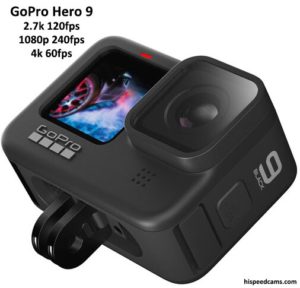
The action camera market has been suffering from consolidation, copycats, and lack of innovation in the last few years. After all the GoPro Hero 4 Black was probably the pinnacle of slow motion features on the action camera line with 240fps at 1080p. We have seen very little improvement here and the only real quality camera in 2020 for the Action category is the Hero 9 Black.
4k Frame rates: 60, 30, 24 fps
- Linear Lens 240, 120, 60, 30, 24 fps
- Linear + Horizon Leveling 240, 120, 60, 30, 24 fps
- Narrow Lens 240, 120, 60, 30, 24 fps
- Wide Lens 120, 60 fps
- Linear Lens 60, 30, 24 fps
- Linear + Horizon Leveling 60, 30, 24 fps
- Narrow Lens 60, 30, 24 fps
So no 120fps 4k here, GoPro is actually very conservative here with barely changing the specs of the Hero 8 Black. You get better stabilization, you get a better screen interface in the front and back, and better battery life.
GoPro Hero 9 Black Slow Motion 240 FPS by Pascal Power:
The 240fps mode is adequate but will not win many contests for image quality. We see aliasing and artifacts almost everywhere in the frame. We see pixelation in diagonal lines and fine detail. 120fps 1080p is an improvement but can be beaten by many phones. In many cases, the action camera can be easily replaced by a stabilized phone or one with a handheld gimbal.
We were disappointed by the Hero 9 Black but the slow motion is not their primary market here and the company is trying to survive copycat action cameras coming out every other month for very little money. The OSMO Action camera from DJI was the first real competition we have seen in the space for GoPro in price and form factor but it was not updated this year. We actually think the OSMO Action was not performing as expected in the sales department and DJI wanted to milk the product an extra year just to get their investment back. We however feel that DJI will release an Action 2 before they give up in the Action Camera market segment.
I’m obsessed with the GoPro Hero 9 slow motion – 240fps by TheMattyAP:
GoPro has placed the price on the Hero 9 black at $449 which is quite high considering the competition is hovering at $200 on the OSMO Action and the Hero 8 Black is just under $250. If slow motion is what you are after, the Hero 8 Black makes better sense as the quality of the frame rates is identical between both cameras except for the Hypersmooth stabilization working in all modes on the Hero 9 Black. So an older model makes more sense economically here.
Unless things change a lot with a new Hero 10 in 2021, we feel the slow motion component on these cameras is going to be stuck at low quality. 120fps 4k should at some point show up in the Hero cameras but we rather see better 1080p slow motion with a 480fps mode. You could wait and see for a Hero 10 before committing any money to an action camera, and who knows a $250 Hero 9 could be possible by the end of 2021 saving you considerably for waiting.
![]()
Professional but Affordable Slow Motion Cameras:
3rd Place: edgertronic SC2X
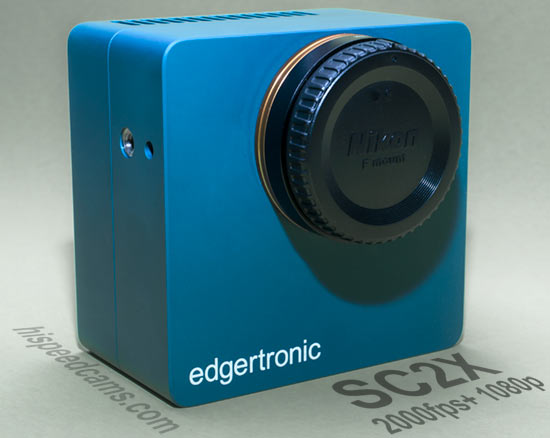 There are very few quality slow motion cameras you can actually afford. The edgertronic SC2X with over 2000fps full 1080p HD quality using an APS-C sized sensor is our pick for uncompromising broadcast-quality high-resolution slow motion capture. See our full review of the SC2X here!
There are very few quality slow motion cameras you can actually afford. The edgertronic SC2X with over 2000fps full 1080p HD quality using an APS-C sized sensor is our pick for uncompromising broadcast-quality high-resolution slow motion capture. See our full review of the SC2X here!
The camera launched with 1910fps 1080p as a top broadcast spec but an Overclocking Software Update transforms the camera into a 2000fps, 2200fps and up full 1080p HD monster. As with all software updates on the edgertronic line, these are free of charge.
While the camera’s price tag at $15,990 may put off some enthusiasts and small studio buyers, it is really a steal for this kind of quality. A camera that does full HD 1080p at over 2000fps is usually reserved to $50k USD kits without it being ready to shoot. Those other cameras require expensive memory modules, cabling, monitors and more just to start recording. The edgertronic SC2X comes in a ready to shoot package which also includes a Nikon f1.8 50mm lens and all the cables you need to start shooting out of the box. It even includes an 8GB SD card which allows you to save about 40 clips in H.264 high-quality 1080p format and over 60 clips in lower quality compression which is still better than most.
In our full review, we took the camera through its paces and it impressed us with the ability to retain excellent detail across all of our adapted lenses with no hints of aliasing or moire that could ruin shots. This camera is ready for TV and Film production which is the primary market of the SC2X. The camera also does 2,814 fps at 720p HD if you need more speed and if you add overclocking up to 3,642fps at that resolution. The camera tops out at over 24,000fps at the reduced resolution of 1920*96 pixels.
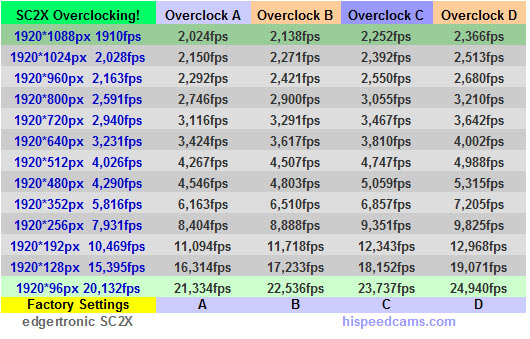
The edgertronic SC2X is the first affordable Full HD 1080p camera that you can really own, with ease of use to boot; this makes it our professional camera of the year and should be top on the list for any serious video producers that want that edge in super slow motion!
For more information and ordering an edgertronic camera visit: https://edgertronic.com/our-cameras/sc2x
2nd Place: Chronos 2.1 HD
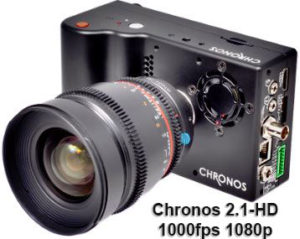
The Chronos 2.1 is the evolution camera that spawned from the excellent Chronos 1.4c Kickstarter camera project. While this camera launched in April 2019, it was just widely available in early 2020 and then it dried up again due to component shortages from Asia exacerbated by COVID 19. As of now,
new camera orders are expected to ship by March 2021.
Chronos 2.1 HD Main Specs:
- 1080p, 4/3” format image sensor captures 2.1 gigapixels per second for 1004fps at full resolution, and up to 100 000fps
at lower resolutions. - 8GB, 16GB and 32GB high-speed RAM buffer options for 2.5, 5.5 and 11 second record time respectively.
- High sensitivity base ISO of 500 (Color) and 1000 (Monochrome) enables shooting with modest lighting.
- Completely standalone, untethered operation.
- Field-swappable internal battery EN-EL4a lasts for 1 hour of recording.
- Runs indefinitely on AC adapter or external power source.
- H.264 Recording In Camera & Uncompressed DNG RAW
- Many lenses supported: Nikon F, Canon EF, Micro Four Thirds and C mounts available as field-swappable options.
- Focus peaking highlights sharp edges for quick and perfect focus.
- Zebra lines help you set correct exposure.
- Pixel pitch 10um
- Electronic global shutter, 1/fps to 10us (1/100 000 s)
- Dynamic range 10.3 stops (62.4 dB) (preliminary)
- Bit depth 12-bit
- 5″ 800×480 capacitive touchscreen, 1000 nit daylight visible
- Cooling Active cooling, variable-speed fan
- Dimensions 155mm x 96mm x 67.3mm (6.11″ x 3.78″ x 2.65″) without lens
- IR Filter 650nm, user removable, 24 x 16 x 1.1mm
- Cooling Active cooling, variable-speed fan
- Network: Gigabit Ethernet
- Trigger Two Trigger inputs/frame strobe outputs (BNC and Aux)
- Audio* Microphone/Line input, headphone output
- Video HDMI monitor output
- USB USB type A (host) and micro B (device)
- SATA eSATA 3Gbps

Krontech.ca has provided a special code for readers of HSC when purchasing their gear. Use code: “HISPEEDCAMS5” for 5% discount at checkout on Chronos store, One use per new customer!
Chronos 2.1 HD Unboxing & Demo Shots! by HarrisonTheEditor
We have been impressed by the performance and quality of this camera since it launched and it still represents the best price / performance combination in the high speed video world. A larger 4/3 ” sensor delivers much better image quality than what the 2/3rds inch in the original Chronos 1.4c could deliver. 1000fps at 1080p RAW DNG for $5000 USD is unbeatable.
There have been reports of vertical and horizontal banding with this camera at lower light levels and at higher frame rates. As with any camera that shoots slow motion, the calibration in black is paramount, and in the case of the Chronos 1.4 and 2.1 cameras you need to let the gear warm-up to get the components to a hot enough temperature that the black calibration gets rid of most of the noise and banding. We have ordered a Chronos 2.1 HD Camera and it should arrive early next year, then we will be able to test and offer our full review and tips. We expect to get clean images at proper calibration and be able to produce broadcast quality material without much trouble.
We recommend the Chronos cameras for ease of use, affordability, and performance for anyone looking for serious slow motion gear that is truly affordable.
For more information about the Chronos 1.4c and 2.1 HD cameras plus ordering information please visit: http://www.krontech.ca
Krontech.ca has provided a special code for readers of HSC when purchasing their gear. Use code: “HISPEEDCAMS5” for 5% discount at checkout on Chronos store, One use per new customer!
1st Place: Freefly WAVE 4k Slow Motion Camera!
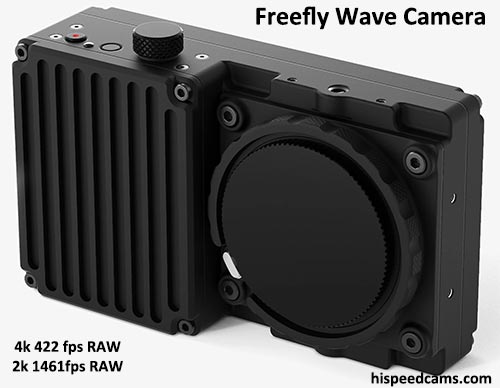
Out of the blue, the Freefly WAVE 4k slow motion camera launched in early October of this year. It is the first camera by the company that started the three-axis gimbal stabilizer craze with the MOVI earlier in the decade. It is also the first slow motion camera that is widely available which uses a flash memory system to record multi-minute super slow motion at a variety of resolutions.
The recording is limited by your available internal SSD memory only and in theory, it could increase as fast SSD memory modules increase in density. This is the same kind of recording system first pioneered by the fps1000 camera line which sadly went out of business as development costs overwhelmed the project. While a few of those cameras shipped, it was never a widely available product.
Wave Camera 4k Slow Motion Specs:
Continuous Capture Time:
- 4096 x 2176, 422fps, 1TB 19min
- 4096 x 2176, 422fps, 2TB 39min
- 2048 x 1088, 1461fps, 1TB 23min
- 2048 x 188, 1461fps, 2TB 45min
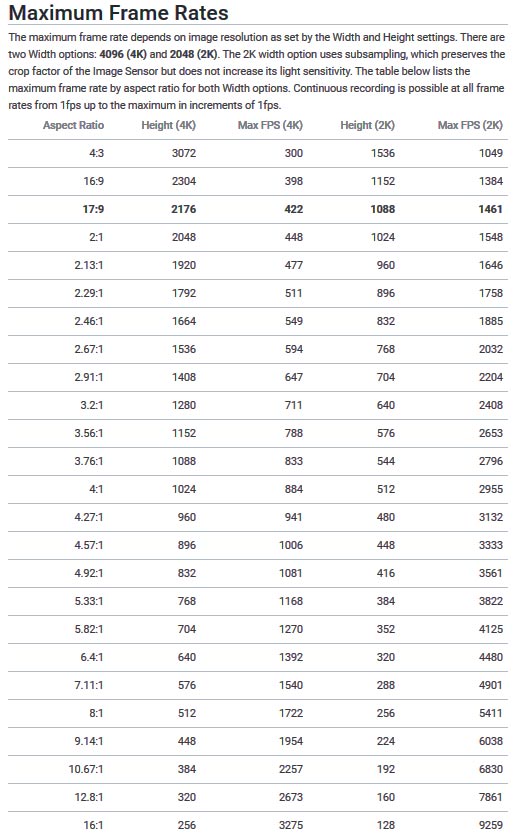
The camera uses a 4:3 aspect ratio from the sensor which is kind of odd but allows for a variety of frame sizes including anamorphic capture if stretch in post. This seems to be an ideal camera for Anamorphic slow motion. Of note is that the Krontech Chronos 2.1 HD is also using a 4:3 sensor which in theory can be used with Anamorphic glass.
— Image Sensor —
- Format – S35
- Aspect Ratio 4:3
- Pixel Size 5.5μm x 5.5μm
- Native Resolution 4096 x 3072
- Active Area 22.53mm x 16.90mm
- Shutter Type Global Electronic
- Native ISO 250
— Lens Mount —
- Standard Lens Mount – E-mount
- Removable – Yes
- Positive Locking – Yes
- Electronic – No
— Recording —
- Media
- Internal SSD
- Media Size – 1TB or 2TB
- Format –Compressed Bayer RAW
- Native Bit Depth –10-bit
- Compression Ratio
- Typical – 5:1 to 6:1
The Price of the WAVE starts at $9,995 for the 1TB Model
- Wave with 1TB SDD – $9,995
- Wave with 2TB SSD – $10,995
The image quality we have been able to see is very good and it should only improve from here as the imaging code matures. This is real 4k recording at 420fps which is really only reserved for cameras that cost orders of magnitude more like the Phantom Flex 4k. That camera can shoot 1000fps in 4k RAW but that will also push you back anywhere from 75k to 120k USD depending on the setup. The Freefly WAVE is as of now the most innovative camera we have seen this year and one that may finally usher a plethora of 4k slow motion cameras.
We believe this is the camera of the year at HSC even with the lack of a built-in screen which may put off some buyers. If this is their first camera, then a version 2 building on their first effort could really make Phantom Flex performance something attainable for the midrange professional.
For more information on the Freefly WAVE Please visit their official site here!
P&S Prosumer Cameras: Sony RX100 VII & Sony RX100 VA!
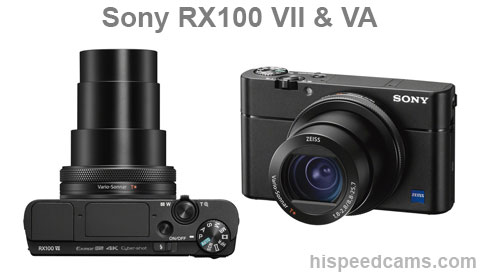
For the fifth year in a row, the RX series by Sony is featured in this category as there is no good comparable alternative. These cameras have up to 960fps in the US and 1000fps in Europe as specs and have up to 3.8 seconds recording in high-quality mode at higher frame rates.
The new RX100 VII brings all the technology of the RX100 VI with its super long compact zoom at 24-200mm F2.8-4.5 lens attached to this little camera plus the killer capability of shooting 20fps stills with no blackout with full subject tracking by using the Sony Pro Autofocus technology on their Alpha cameras reduced to a pocket P&S camera. It also adds S-Log3 and HLG gamma settings, 2.36m-dot OLED electronic viewfinder, 3.0″ 921.6k-dot LCD touchscreen with Bluetooth and Wi-Fi connectivity for sharing imagery to a linked mobile device
Sony RX100 VII | What a $1,199 Point and Shoot Gets You by Potato Jet:
The big selling point of the camera is the 315 AF Phase detect points with full eye-tracking which is probably the best in the business. Still the lens is so long, meaning that low light shooting will be less forgiving than the RX100 VA of 2018 which we still recommend as a second option here in this category.
The RX100 VA has a f/1.8 to 2.8 8.8 to 25.7mm (35mm Equivalent Focal Length: 24 to 70mm) 2.9x optical zoom which is ideal for shooting slow motion sequences. The video quality on the slow-mo HFR mode is identical in the RX100 VII and the VA so it ends up being a choice about lens light-gathering power vs reach and the better AF module on the RX100 VII. We still believe that if you only need the HFR version, then the RX100 VA is the clear option once again in this segment and deserves your attention as an all-around shooter for any situation.
| RX100 VII & VA HFR Resolution Table: | 1920×1080 (120p/100p/60p/60i/50p/50i/24p) 1824×1026 (250p/240p) 1824×616 (500p/480p/250p/240p) 1292×436 (500p/480p) 1244×420 (1000p/960p) 912×308 (1000p/960p) |
|---|
The Sony RX cameras remain the best performing cameras in the prosumer space without interchangeable lenses, their 1″ sensor is very good in low light and the video quality in good light is nearly flawless.
Sony RX100 VII slow motion test – 960 fps by gadgets and tech:
Be aware that all the RX series only record near Full HD quality at up to 240fps, everything after that resolution the quality drops considerably and pixels are up-sampled to 1080p for the recording. Resolution above 240fps is under 720p HD and at 1000fps its under NTSC VGA.
Sony RX100VA night video test, slow motion & color grading & cinematic video by International Departures:
The Sony RX Series continues to be the best slow-motion camera for value in the point & shoot prosumer market, no other brand comes close. Their CMOS Stacked Sensor technology with included memory and 1/32000 shutter speed allow for some amazing capabilities with a lower price tag.
The Sony RX100 VII for longer zoom, better Autofocus and RX100 VA for Pocketable all-rounder earn our HSC Top Pick for 2020 for this segment!![]()
Mirrorless Cameras with High Frame Rates:
This category is all about robust features for stills and video in a mirrorless camera body from a major manufacturer. We have three choices that all offer higher frame rates. Sadly not a single of these options has it all so you have to decide and compromise on which one to choose regarding the maximum frame rates they offer and at what quality.
3rd Place: Panasonic LUMIX S5:
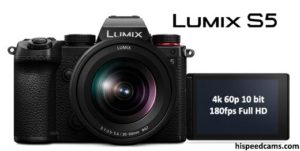
When the GH5 was announced about 3 years ago it came with a 180fps 1080p mode that was better than many camera’s 120fps modes and quickly became our favorite Lumix camera for slow motion as we noticed how the quality of the 240fps mode on the GH5s low light geared camera was heavily inferior in resolution. The GH5 really became the best value along with the G9 for 180fps slow-mo modes in Full HD.
Now in 2020 we have the Lumix S5 full frame camera that can also shoot 180fps and 150fps in full HD along with 60fps in 4k with 10bit color and internal recording. This camera is basically a direct successor to the GH5 micro 4/3 camera but with a much improved full frame sensor that can compete in low light with some of the best cameras out there. You will not be able to use your Lumix 4/3ds lenses on the new system as the L mount imaging circle is pretty big and cannot fill the sensor with the smaller lenses. You will need to buy a whole new system which has put off a lot of 4/3 Panasonic users that wanted an upgrade path.
All is not lost as a Panasonic GH6 will probably show up one of these days with 8k as a probable feature and maybe improved slow motion.
In the meantime the Panasonic Lumix S5 hits ticks most of the boxes in regards to stills and video recording with a high quality full frame imager, IBIS and V-Log color space. The camera however maxes out at the following frame rates:
Slow-Mo Modes & Bit Rates:
- 4k 60fps 10-Bit Internal
- 1080p 120fps, 150fps slight crop and resolution loss.
- 1080p 180fps – More severe crop and resolution loss.
- H.264/MP4 4:2:0 8-Bit
UHD 4K (3840 x 2160): 23.976p/25p/29.97p [100 Mb/s]
Full HD (1920 x 1080): - 23.976p/25p/29.97p/50p/59.94p/100p/119.88p/180p [20 to 28 Mb/s]
We get a maximum of 180fps and not 240fps like the frame rate offered on the GH5s. We also get reduced resolution and a windowed mode compare to the GH5 which is our favorite 180fps camera from Panasonic. That camera has very good quality approaching full HD at 180fps and true full HD at 120fps. Here we get pretty good 120fps but quality starts to decrease at 150p and 180p.
180fps Slow Motion Test: Panasonic Lumix S5 (Frying the Schintzel) by Digimanie.cz:
The quality as you can see above is actually not that bad and can be used in HD production when shot in good lighting. It will not be the best out there but it is actually holding it’s own against other cameras. However, we get no 120fps 4k as other cameras on our list and the Autofocus is DfD based which is only contrast based using AI algorithms. That is the feature that really keeps the S5 behind the pack, Panasonic needs to abandon DfD AF and go all in on dual pixel Phase AF for all subsequent cameras. Being married to a system that does not perform well in video but excellent on Photos is not good enough for today.
At $1997.99 for the body only kit and $2297.99 for the Body plus LUMIX S 20-60mm F3.5-5.6 Lens are very appealing on pricing compared to what is offered out there.
This is an excellent camera that would be on top of your list if the cameras from Canon and Sony did not exist. However if you are into the Lumix Full Frame ecosystem, you surely cannot go wrong with the Lumix S5 which is a Mini S1H camera for less than half the price.
2nd Place: Canon EOS R5
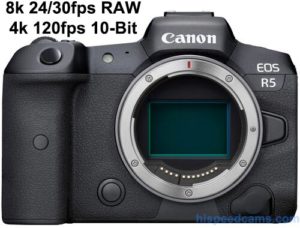
Canon has now completely transitioned to a mirrorless future for its midrange cameras. SLRs sales have been drying up and that trend seems to continue indefinitely. The benefits of mirrorless like low light viewfinders, hybrid AF, faster operation, and smaller body sizes make it the clear choice for the engineering focus going forward. The Canon EOS R5 is the clear successor for the Canon EOS 5D SLR line as it builds on the true and tested body style and creates a camera that is not only class-leading but industry-changing.
Canon EOS R5 Recording times:
- 8k RAW 30p/24p – 20 Minutes rec time
- 8k NON-RAW 30p/24p – 20 Minutes rec time
- 4k 120fps – 15 Minutes rec time
- 4k 60p – 35Min Rec Time No Crop
- 4k 60p – Crop Mode 5.1k Oversampling – 25 Min Rec Time
- 4k High-Quality 30p- 8.2k Oversampling- 30 Min Rec Time
- 4k 30p – No Overheating Limit
This is now an 8k capable camera with 24p, 25p, and 30p recording in the new resolution albeit for a limited time before overheating. There is also a very good 120fps 4k recording option that allows up to 15 minutes of continuous recording in this mode. We are now seeing several cameras that are able to record at 4k UHD at 120fps and we expect 2021 to have many more cameras able to do this as standard.
Canon EOS R5 – 120fps 4K Real World Test Film – Tea by the Lake by James M. Williams:
As you can see the video quality at 120fps 4k is quite good and will be able to shine in your production. It is of note that no other high frame rates above 60p are available at lower resolutions. Could be a limitation of the sensor and not a deliberate oversight. We however feel that this camera should have been able to shoot at least 240fps 1080p with little trouble and maybe reach 480fps Full HD with some engineering behind it.
This is a camera that is great for stills and outstanding for video if you can live with the overheating. Excellent autofocus in video and stills, portable and dependable. The EOS R5 is the camera that Canon was able to bring to the market as a first real try at professional mirrorless EVF cameras. Now imagine if they push this technology further? They can literally regain all the market share they have lost to Sony and Panasonic due to them resting on their laurels when it comes to improved footage features.
The camera is widely available at $3,799 body only or $5, 425 for the Canon EOS R5+ RF 24-105mm F4 L IS USM Lens kit!
1st Place: Sony a7s Mark III
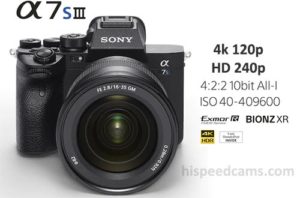
Sony sure took its sweet time to release the successor to the a7s Mark II. The new a7s Mark III is an evolution of the previous model with a lot of improvements in speed, battery life, and powerful features. It even has better noise handling at high ISOs which are the strength of this camera line. Now we have 1080p 240fps and 4k UHD at 120fps. The 4k is excellent quality while the 1080p is really 1408 x 804 pixels at 240 or 200 fps. This makes the feature good to have but not production quality. By having this feature added it becomes a better slow motion camera than the Canon R5 but we would have loved to see a flawless quality 240p at 1080p on the a7s Mark III.
Sony a7s III Main Video Specs:
| Video Recording Modes | H.265/XAVC HS 4:2:2 10-Bit UHD 4K (3840 x 2160) at 23.976p/25p/29.97p/50p/59.94p/100p/119.88p [50 to 280 Mb/s] H.265/XAVC HS 4:2:0 10-Bit UHD 4K (3840 x 2160) at 23.976p/25p/29.97p/50p/59.94p/100p/119.88p [30 to 200 Mb/s] H.264/XAVC S-I 4:2:2 10-Bit UHD 4K (3840 x 2160) at 23.976p/25p/29.97p/50p/59.94p [240 to 600 Mb/s] Full HD (1920 x 1080) at 23.976p/25p/29.97p/50p/59.94p [89 to 222 Mb/s] H.264/XAVC S 4:2:2 10-Bit UHD 4K (3840 x 2160) at 23.976p/25p/29.97p/50p/59.94p/100p/119.88p [100 to 280 Mb/s] Full HD (1920 x 1080) at 23.976p/25p/29.97p/50p/59.94p/100p/119.88p [50 Mb/s] H.264/XAVC S 4:2:0 8-Bit UHD 4K (3840 x 2160) at 23.976p/25p/29.97p/50p/59.94p/100p/119.88p [60 to 200 Mb/s] Full HD (1920 x 1080) at 23.976p/25p/29.97p/50p/59.94p/100p/119.88p [16 to 100 Mb/s] |
SLOW & QUICK MOTION (SHOOTING FRAME RATE) :
NTSC mode: 1 fps, 2 fps, 4 fps, 8 fps, 15 fps, 30 fps, 60 fps, 120 fps, 240 fps
PAL mode: 1 fps, 2 fps, 3 fps, 6 fps, 12 fps, 25 fps, 50 fps, 100 fps, 200 fps
SONY A7SIII in 10-bit 120fps! Surf in slow-motion by Stan Moniz:
https://www.youtube.com/watch?v=Gf6gkke5nk8
By being an excellent low light camera ISO up to 409,6003 and 15+stop dynamic range, the a7s Mark III is ideal for higher frame rates as it allows to shot the 4k 120fps mode in very low light conditions with excellent results as you can see in the video above. We recommend it as a 4k 120fps camera with no reservations other than it has a 1.1x crop in this mode which is not a deal-breaker. It is however a camera that can fully track any subject even at 120fps 4k with its class-leading Autofocus.
The Sony a7s Mark III is available for $3,498 body only and in a variety of lens kits. This is probably the best mirrorless video camera ever released which makes it an easy decision to acquire.
![]()
End of 2020 Message to Our Readers:
2020 the year of the COVID 19 Pandemic, has been a difficult year for everyone, some more than others and it has also been a year of heroes in the frontline of this crisis, these include our first responders, doctors, nurses, hospital employees, grocery delivery personnel, and many more that risk their lives every day for others.
Thank you for visiting our site and contributing with tips, comments or just your frequent visits. Our site will remain open as long as you are interested in the information we present to you.
We strive here at HSC to catalog and weed through the camera market to find the hidden gems that are able to produce high frame rates on a budget. By using our links to products and clicking our banners you help us continue to exist. Even if you do not buy a product directly from a link, any product that you buy through our links helps us continue our mission. So the next time you visit and need to buy something, please click a product link first and then continue shopping at no extra cost to you.
We thank you all and we hope you have a great and healthy 2021! 
Shoot Great Slow Motion Stuff! -HSC
Check out: Best Slow Motion Cameras of 2020!
Check out: Best Slow Motion Cameras of 2019!
Check out: Best Slow Motion Cameras of 2018!
Check out: Best Slow Motion Cameras of 2017!
Check out: Best Slow Motion Cameras of 2016!
Check out: Five Best Slow Motion Cameras of 2015!

